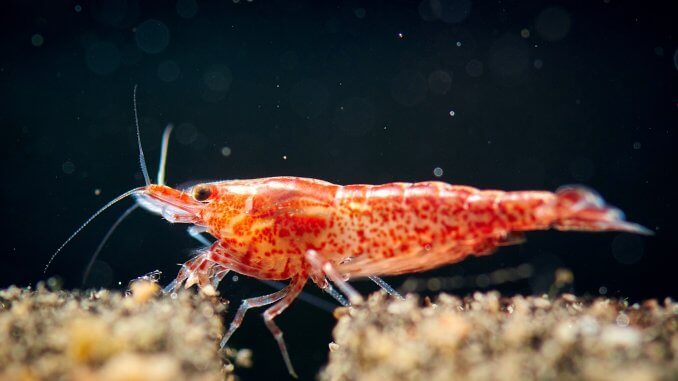
The cherry shrimp is a freshwater shrimp of the Atyidae family. These shrimp are graded by their color. There are five color grades available: standard cherry shrimp, sakura cherry shrimp, fire red cherry shrimp (in low and high grades), and painted fire red cherry shrimp.
Regardless of their grading, cherry shrimp are small, vibrant invertebrates that are easy to care for. The shrimp are popular among aquarists due to their affordability and their tank-cleaning habits.
TABLE OF CONTENTS
Cherry Shrimp Facts & Overview
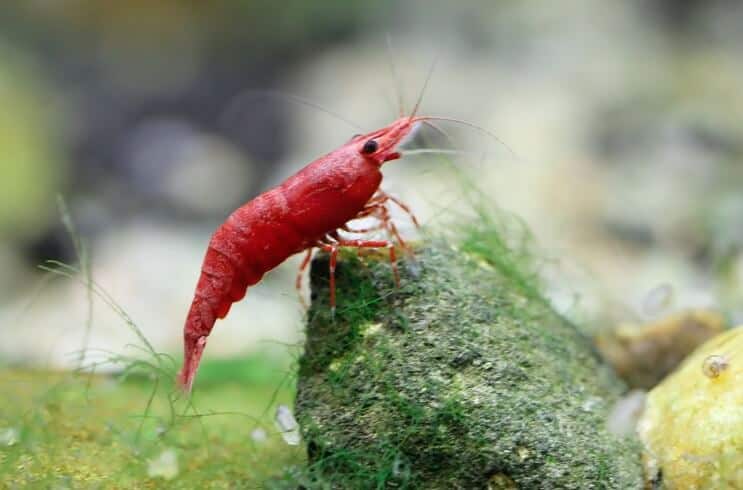
| Scientific name: | Neocaridina davidi |
| Common names: | Cherry shrimp, red cherry shrimp, cherry red shrimp, fire cherry shrimp, fire shrimp |
| Distribution: | Taiwan |
| Size: | 1.5 inches |
| Life expectancy: | 1–2 years |
| Color: | Various shades of red |
| Diet: | Omnivore |
| Temperament: | Peaceful |
| Minimum tank size: | 5 gallons |
| Temperature: | 65–85°F (23–29°C) |
| pH: | 6.5–8.0 |
| Hardness: | 4.0–14.0 dGH |
| Care level: | Easy |
Origin
Wild cherry shrimp originate in Taiwan, where they’re still commonly found today. The shrimp’s natural environment is rocky streams and ponds with dense vegetation.
Adult Size & Lifespan
Adult cherry shrimp grow up to 1.5 inches long. Males are smaller than females and grow to about 1 inch in length.
The average lifespan of a cherry shrimp is 1–2 years. Most of these shrimp only live up to 1 year because they struggle to thrive during changes to their environment, such as fluctuating water conditions.
Availability
Cherry shrimp are widely available in pet stores. With that said, the biggest selection of cherry shrimp is online.
You can find cherry shrimp in the following reputable fish stores:
- LiveAquaria sells standard red cherry shrimp and chocolate cherry shrimp
- Imperial Tropicals sells cherry shrimp and sakura grade cherry shrimp
The cost of a cherry shrimp depends on the shrimp’s grading. Standard cherry shrimp are the cheapest, costing between $1.50 and $3 per shrimp. High grades of cherry shrimp cost up to $8 per shrimp. Commonly, stores sell cherry shrimp in groups of 3, 6, 12, or more.
Appearance & Behavior
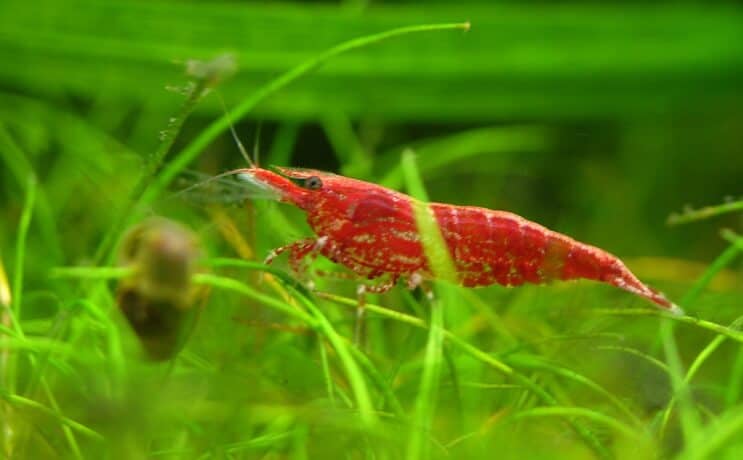
Cherry shrimp are small shrimp in various shades of red. These shrimp are easygoing but nervous. This species of invertebrates spends most of its time scavenging in the bottom of the tank.
Colors, Patterns, and Size
Cherry shrimp have a distinctive shrimp-shaped head, with a pointy rostrum (nose) and four antennae — one pair longer than the other. The shrimp have eyes that protrude on stalks on either side of the rostrum. The species also has three pairs of short legs beneath the mouth that help the shrimp scavenge for food.
The cherry shrimp’s abdomen has six overlapping shell segments as a covering and five pairs of legs for swimming.
Cherry shrimp come in a range of reddish colors, and are graded based on their vibrancy:
- Standard cherry shrimp — are pale or transparent with red markings
- Sakura grade cherry shrimp — have more red coloring on their bodies than standard cherry shrimp, but still have clear patches
- Fire red low-grade cherry shrimp — are almost entirely red
- Fire red high-grade cherry shrimp — are completely red
- Painted fire red cherry shrimp — are solid red, with full coverage of color that includes their legs
Aquarists also selectively breed cherry shrimp to produce other color morphs, including blue velvet, green jade, yellow sakura, chocolate, and orange sakura shrimp.
Females have bolder coloring and are larger than males. When the shrimp reach sexual maturity, females develop egg-holding saddles on their stomachs. When stressed, cherry shrimp become paler than usual. The shrimp lose pigment as they age.
Typical Behavior
Cherry shrimp are shy and peacefully inhabit the lower region of the tank. These shrimp are most comfortable in groups of at least four.
The species is known to hide in caves and behind plants for the first few weeks after being introduced to a new tank. These shrimp should eventually feel comfortable enough to explore their surroundings in daylight. Cherry shrimp enjoy eating algae from the walls, rocks, and other surfaces in the tank.
Cherry Shrimp Tank & Water Requirements
The habitat for a cherry shrimp should include a warm, well-established tank with plenty of plants, crevices, and moss. The tank should be at least 10 gallons in size.
Habitat and Tank Requirements
Mimic the cherry shrimp’s natural habitat as closely as possible with a pebbly substrate and driftwood for the shrimp to eat algae off of.
Java moss is a great moss to use in a cherry shrimp tank because the moss provides an ideal hiding space for shrimp. Other live aquarium plants, like java fern and anubias, provide good cover for the shrimp when molting. Plants also collect biofilm which is a nutritious food source.
Cherry shrimp don’t have specific lighting requirements, so tank lighting can be tailored toward healthy plant growth.
The shrimp don’t need a resting spot to breathe air above the water as long as the water’s oxygen levels are adequate.
Water Conditions
Ideal tank conditions for cherry shrimp are:
| Water type: | Slightly soft, acidic, well-oxygenated freshwater |
| Tank size: | Minimum 10 gallons, or 2–5 shrimp per gallon |
| Water temperature: | 65–85°F (23–29°C) |
| Substrate: | Fine pebbles |
| Tank setup: | Lots of plants, driftwood |
| Acidity: | 6.5–8.0 pH |
| Water hardness: | 4.0–14.0 dGH |
| Filter: | Yes. Cherry shrimp are sensitive to nitrite and ammonia spikes, so a strong filter is required to maintain clean water. Sponge filters are safest for shrimp |
| Lighting: | Not necessary if natural lighting is available, although lighting can be used for plant growth |
| Water heater: | Yes, to maintain a warm water temperature in the tank |
| Bubbler: | Yes. A bubbler oxygenates the water, which the shrimp need to survive |
Cherry shrimp become easily stressed if they’re housed in changing water conditions. It’s essential to maintain consistently clean, soft, and oxygenated fresh water in the tank.
Care & Diet

Caring for cherry shrimp is easy. These invertebrates eat a diet of algae and tiny microorganisms. Common issues affecting cherry shrimp are molting problems, shell diseases, and parasites.
Diet and Feeding
In the wild, cherry shrimp are scavengers that feed on whatever they can find, such as plant matter and microorganisms. The shrimp are omnivores and are happy to eat most foods that they can fit in their mouths.
Feed cherry shrimp a diet of shrimp pellets, algae wafers, and blanched vegetables in captivity. These shrimp are tiny and should only be fed a small pinch of food two or three times per week. Remove leftover food two hours after feeding the shrimp to prevent it from polluting the tank.
Cherry shrimp enjoy eating algae off the walls and surfaces in the tank. Encourage algae growth by adding lots of plants to the tank and placing the tank in an area that receives several hours of direct sunlight per day.
General Care
The cherry shrimp is one of the hardiest shrimp species and requires minimal care and upkeep. However, poor water quality can have a drastic effect on these shrimp, so you should invest in a powerful sponge filter and perform two 30% water changes per week to prevent a buildup of waste in the tank.
Cherry shrimp are social shrimp and should be housed in groups of at least 10. This species of shrimp is nervous and needs plenty of shelters to hide and breed.
The shrimp don’t need any special lighting, and supplements aren’t necessary if you provide them with nutrient-fortified foods. If you prefer, add measured amounts of liquid calcium to the tank according to the product’s instructions.
Common Problems
Cherry shrimp are sensitive to environmental changes and subject to several common health problems.
Water treatments like copper, malachite green, and CO2 can be dangerous to cherry shrimp, so be wary of the treatments used for fish inhabitants.
Molting Problems
In healthy conditions, young cherry shrimp molt every one to two weeks, and adults molt every three to four weeks.
Poor or fluctuating water conditions can lead to molting problems, such as the White Ring of Death, which occurs when the shrimp’s exoskeleton splits into two. This causes the shrimp to get stuck in its molt and potentially die.
Prevent molting problems by maintaining clean, optimal water conditions and consider adding calcium supplements to the tank.
Parasites
Cherry shrimp can contract several different parasites, such as a parasite known as Vorticella, a white, fuzzy, mold-like growth on the shrimp’s body. If Vorticella is left to multiply, it can eventually get into the shrimp’s gills. This growth will reduce oxygen levels and suffocate the shrimp.
Prevent Vorticella by keeping the tank clean. Speak to your veterinarian about potential treatments for affected shrimp.
Is a Cherry Shrimp Dangerous?
Cherry shrimp are small, delicate, and safe to handle. Handling the shrimp isn’t recommended due to their small size. Using an aquarium net is the safest way to transport shrimp.
Cherry shrimp are peaceful invertebrates that don’t display hostile behaviors or attack other tank inhabitants. These shrimp are shy and retreat from conflict when possible.
Breeding
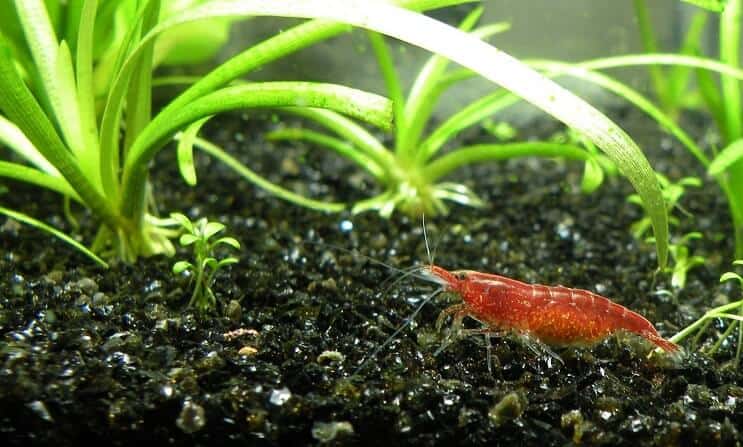
The cherry shrimp is one of the easiest types of shrimp to breed. This shrimp species reaches sexual maturity between four and six months of age.
Here’s how to successfully breed cherry shrimp in captivity:
- Prepare the aquarium for breeding. Ensure the tank is heavily planted to provide security during the breeding process. Raise the water temperature to 82°F. The aquarium should be established, not newly-cycled, to ensure that the tank contains organisms for the shrimp babies to feed on
- Condition a group of around 10 male and female shrimp for breeding by feeding them a high-protein diet of pellets
- When the females are ready to breed, they release sexual hormones into the water to attract the males. The males will find the females and deposit their sperm
- After mating, females carry their eggs beneath their tails and fan their tails to provide the eggs with oxygen
- The eggs will hatch after about 30 days. Keep the babies in the same aquarium as the parents. The babies are independent from birth and will eat biofilm and algae for their first few days of life
- Continue to feed the adults as normal. Eventually, the babies will join in with the adult feeding
Tank Mates
Cherry shrimp are small, peaceful, nervous invertebrates that get along well with similarly-sized, slow-moving, peaceful tank mates.
The shrimp should live in groups of at least 10, and shouldn’t live with large or predatory fish that tend to eat shrimp. Unsuitable tankmates include cichlids, oscars, and discus.
Ideal tank mates for cherry shrimp are:
- Dwarf gouramis
- Small tetras
- Catfish
- Small plecos
Suitable non-fish tank mates for cherry shrimp are:
- Freshwater snails (such as mystery snails, ivory snails, nerite snails, and Malaysian trumpet snails)
- Other shrimp (such as ghost shrimp, vampire shrimp, and Amano shrimp)
Should You Get a Cherry Shrimp for Your Aquarium?
Cherry shrimp are peaceful, hardy, and brightly-colored invertebrates. These shrimp are useful tank-cleaners and can be entertaining to watch.
You should get cherry shrimp if you have a peaceful aquarium with enough room for at least 10 bottom-dwelling inhabitants. Don’t get cherry shrimp if your tank contains predatory fish that could eat the shrimp, or if your tank’s water conditions are unsuitable for this shrimp species.
Despite their nervousness and need for well-established, consistently clean water, cherry shrimp are ideal for beginner fish keepers who want to learn how to look after a non-fish aquatic species.

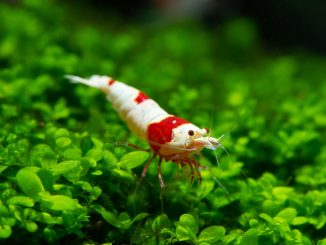
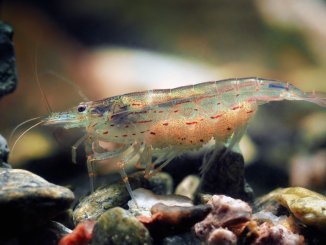
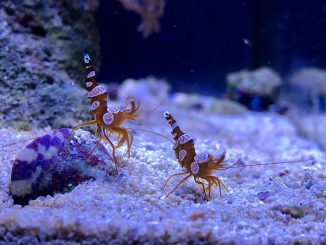
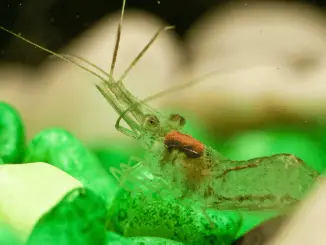
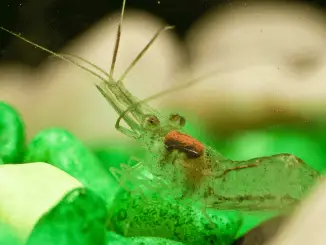
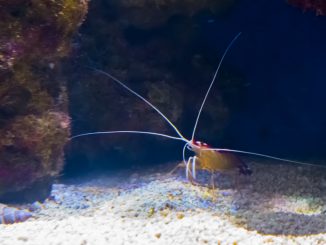
I added two tiny Cherry shrimp to my 20 gallon aquarium with 5 neon tetras, 4 platters, a dwarf gourami a pleco, and two small German rams. At first they hung out in the grass at bottom, an hour later were climbing tall plants, And no I haven’t seen them since yesterday. Are they hiding or do you think they got eaten there quickly? I do have a dragon rock with a ton of holes and other hiding laces but I thought they would still pop out here and there. Thanks!
Hi Maria, thanks for your message. The Tetras, Platies (I presume you mean them when you said Platters?), Dwarf Gourami and Pleco should all leave your shrimp alone. It is very likely that they were eaten by the German Blue Ram, they love shrimp unfortunately and given the size of your tank, it’s quite likely. Keep an eye out for them just in case and remove them if you do see them. Thanks, Robert
Hi
I have an established tank,
Will madagassca rainbow fish, tiger barbs, tetra and a small kissing gorami be ok with cherry shrimp? Tank has several pieces of bog wood and live plants. Thanks
Thanks this is really helpful. I bought my first cherry shrimp last Sunday, he is in with 2 penguin tetras, 2 guppies, 2 mollies, and 2 little wood shrimp. I think I might have to get him a friend. My wood shrimp are always out and about, busily cleaning up the tank, but the cherry shrimp likes to hide away. I have lots of plants, driftwood, moss etc in the tank so hopefully he is enjoying it. It’s wonderful to see him swim.
Hi Lizzy, thanks for sharing your experience with us. I’m glad you found the article helpful. Thanks, Robert.
I purchased 4 cherry shrimp for a 10 gallon well planted aquarium that had cycled for 4 weeks. Looked like good bacteria on the wood. Checked water quality and temp and thought we were good to go. Acclimated them slowly. Within 4 days they were all dead. No tankmates. The fish store said they are not easy to keep and any thing that might have gotten in my tank, they suggested air fresheners ? Would have killed the. Don’t use air fresheners near the tank. Just how finicky are these guys I really want to try again. The new 4 tetras that I bought are doing just fine in that tank
Hi Linda, you can really tell whether good bacteria has built up just through looking, you need to test the levels in your tank. Did you check the ammonia and nitrite levels? Shrimps can be particularly sensitive to them so you might want to make sure your tank has been established for a few more weeks before adding them. Was there enough algae for them to eat, were you also feeding them other foods? Once your tank is free from nitrites, they should be quite easy to care for. Thanks, Robert
One other possibility for high death rates is the amount of copper. The tetra food and tap water could both be hidden sources of copper. This article is very helpful, but I read somewhere to check other foods that go into a shrimp tank.
They can’t be overly difficult to keep or I wouldn’t be trading them for credit at my LFS. As a newbie, I’ve broken many of the rules thru lack of knowledge and impatience. I went from 6 to around 80 in 5 months keeping them with dwarf puffers. I don’t recommend that, but I knew the risks. The puffers are likely snacking on babies, but they don’t seem to care about the adults.
Is there a time of year that it is best to purchase Cherry Shrimp? I have read some places that they can be sold seasonally but never told what season. Thanks!
Hi John, they’re pretty much available all year round if you search around enough. Thanks, Robert
Looking for another substrate for Red Cherry Shrimp,
I tried Fluval Stratum for 5 gallon Betta tank
but stay KH 0 and pH not stable.
We love our cherry shrimp and ghost shrimp! We’ve gone from 6 guppies to 1, but our shrimp are thriving! They’re growing like crazy, and we find their discarded “skins” that they’ve shed. We’re thinking about going to nothing but cherry and ghost shrimp since they seem to like us.
Hi, I’m about to plant Dwarf Hairgrass into my 45 Gallon corner tank. I would like to know if Cherry Shrimp will eat the young grass if I introduce them at the same time. The tank is very mature (10yrs) and has plenty of well established, thriving plants.
Hi John, dwarf hairgrass makes a great choice for shrimp and they’re unlikely to eat it. Thanks, Robert
Hi,
Looking at breeding cherry shrimp to maintain a population,
Do you need to bring the temperature down after breeding is done or can you keep it at 82°F to have them breed continuously?
For optimal breeding, I’d keep the conditions as close as possible to their natural conditions. This means allowing the temperature to drop occasionally too. Thanks, Robert
Thanks for the info! I am planning a 20 gallon long cherry shrimp breeding tank and was wondering if I could use a moving bed filter with a gallons per hour of ~100. thanks! and just to double check, I should start with 10-15 right?
Dylan, this all sounds great. Good luck with your breeding! Robert
I have a cherry and a rainbow (yellow) dwarf shrimp in there own 1.5 gallon tank and I love it I got them 4 little Marbio moss balls or however you spell it and they love them I do wanna add a nice little piece of wood in there for them for more hiding spots as I only have one smaller plant in there cuz after all it’s only a 1.5 gal but had them for a month so far and both are very active from about 3pm till 8 9pm when its lights out theres not a whole lot of hiding spots but they dont seem to mind seeing theres nothing but them 2 in the tank any advice on these little guys in there smaller environment would be appreciated as they are my first shrimp but water is all good lots of weekly tests to make sure no spikes or changes occur in any of my tanks
Would it be alright to house assassin snails with cherry shrimp?
Hi Taylor, I have heard reports of assassin snails eating shrimps, whereas other aquarists keep them together without a problem. Personally, I wouldn’t risk it. Thanks, Robert
Hello! I have a 37 gallon tank. I started with 10 cherry shrimp 6 months ago, now I have about 40. Should I be worried about too many in the tank? I also have 9 harlequin purple rasboras, 4 neon tetras, 4 khuli loaches, 1 albino bristlenose pleco and 1 lyratail sword. They all seem to be pretty happy, healthy and get along nicely. I also have 1 Dwarf Aquarium Lily Bulb and 1 Anubia Nangi as well as numerous plastic plants.
Hello, your tank is slightly over stocked. If your shrimp continue to breed you’ll need to house them in a separate tank, the Tetras and Loaches like to be kept in groups of at least 5 too. Thanks, Robert
I introduced assassin snails that are breeding I already had 6 shrimp that have bred and I now have 14 /some are minute and swim all over/ so cute. I have a 50 gallon corner tank. It has well established plants that both shrimp and snails literally hang-out on. I was worried as I had a well established tank with a bristle nose, 5 harlequin rasbora,4 cardinal tetra, 5 sidthimunki, 4 tiger barb, 6 white cloud minnows and 2 lemon blue eyed cat fish. The shrimp are fun to watch but we are besotted haven’t never kept any before. Everyone gets along and has their own space. I do have two pieces of driftwood, a slate cave for my plec and half a shaped coconut shell with plants attached. 3 other resting places for fish and shrimp bought from our aquatic centre
I don’t really think it will be a problem, but make sure they have lots of biofilm and surface area for it to grown.
Good day. I recently got shrimp from a friend, he said it’s red cherry shrimp but some of them has a pale brownish color. What other vegetables should i feed them with?
Hi Hergen, If you are planning on feeding them vegetables, make sure they are boiled and blanched first. Ideal veggies include: Spinach, Carrots, Lettuce, Cucumber and Zucchini. Thanks, Robert
I’m currently keepimg them in a 10 gallon tank with a few plants. I’m planning to add some neon tetras, is that ok?
Hi Hergen, yes this will be fine. You can read more about keeping Neon Tetra here: https://www.fishkeepingworld.com/neon-tetra/ Thanks, Robert
I peel a frozen pea and they love it
Would it be ok to have Cherry shrimps with platys and mollies?
Thank you so much
Hi Benoit, yes they will be fine as tank mates. Thanks, Robert
I purchased 3 very tiny cherry shrimp the other day. I added them to my betta tank. They all seem to be doing fine. The betta isn’t so aggressive. He just likes to swim back and forth on one side of the tank or hangout under some plants. At first he kept trying to figure out what one of them was and it kept bolting away from him. But for the past few days he has left them alone. I was told they all will live together fine by some people and others told em that my betta might eat them. I’m glad he hasn’t decided to eat them!But like Is aid, my betta isn’t very aggressive and he’s very relaxed.
I don’t recommend putting Cherry Shrimp with betas, they will eat their offsprings and they will die quickly.
Hi Hannah, this is good to hear because I have a 5 gallon tank with 1 Betta fish. It’s heavily planted but he is quite bold so I haven’t tried anything else with him yet. Sounds like you would recommend cherry red shrimp with a Betta. How big is your tank? Do you think 3 cherry red shrimp is the right number? Are they still ok…? thanks
Hello, I have two aquariums, a 5 gallon and a two gallon that both house many Cherry shrimp. (the larger aquarium also has two Amanos and three small guppies, three tetras, 5 long eel-like loaches and three cordydoras. I intend to use the small aquarium as a breeding aquarium to house different species of dwarf shrimp. I want to add blue velvet or blue dreams shrimp, as well as yellowstripe shrimp. do these shrimp make good tank mates for my cherries? (I have around 23 of them).
Hello Ishay. Your tank is severely overstocked. I would recommend at least a 15 gallon for all those fish, let alone add any more. Additionally, tetras, guppies, and some corydoras require a larger school in order to feel comfortable. Please consider buying a larger aquarium, for the sake of the fish.
Hi can you please tell me how long I should leave a newly set up 17litre tank before introducing baby cherry shrimps
Best bet 2 weeks the longer the better. Some tanks take 6 mounts some less, but I recommend longer the better.
which kind of substrate should i buy for cherry shrimp. there are so many out there i’m not sure which one is the right one. could you kindly point out a few good one for me? thank you in advance
Hi, I first started with amano shrimpmixed in with my betta and Cory’s. I saw the red cherry shrimp at an aquarium shop so I bought some. I love them. I have since set up a 4 gallon planted shrimp tank and now have 8 shrimp in there. Although I have one very small blue one, a tiger shrimp and one yellow one mixed in there now. Had a very bad start and lost about 5 shrimp before i got things right. I think I have things stable now. Been a week and they are doing fine. Just have to figure out how to clean the slime off everything. For the life of me I can’t figure out what’s causing it. My parameters are all stable so i don’t know what’s causing it. The shrimp don’t seemed bothered by it though.
Get an algae eater! My Alamo and cherry shrimp didn’t do the job. I have a 29 gallon tank with 3 amonos, 3 panda corys and several cherry shrimp. Got 3 of of the algae eaters. They keep it nice and tidy and get along with everybody! ☺☺
i want to get cherry shrimp, but i dont want very many, is there a way i could keep them from breeding? would that be unhealthy?
I started out with 12 cherry shrimp in a well established and planted 20 gallon tank. I had some Mystery Snails for a while, but they were not thriving so I gave them to another aquarist and now I have only Cherry shrimp in the tank. They were not breeding after several months until I put a new heater in the tank. A couple of months later, and now I have hundreds, of all sizes. Every few days I put a few algae tabs with spirulina in the tank and they all come running! It’s the cutest thing I’ve ever seen! But I am a bit worried that there may be too many, so I am gradually lowering the temperature a few degrees every day. Will this slow down the population explosion?
Hello
I have a tank with 3 Madagascar rainbow fish, would cherry shrimp be ok in the same tank?
Thanks
I am interested in starting a tank of just cherry shrimp. I currently have a 5 gallon tank with a Java Fern and an Anubias [probably Frazeri] from my betta who recently passed.(The plants won’t hurt/be hurt by the shrimp, right?)
How many shrimp do you recommend I get to start? I found an article that said a 5 gallon could keep 15-20, which differs a lot from what you said here. How many can I keep total? I’m also wondering how to keep their numbers in check so I don’t go over that ammount.
Thanks!
I have an established planted 20 gal aquarium with two African dwarf frogs and 10 cardinal tetras. I read the article about the tetras being fine, but I’m wondering about the frogs, they’re still pretty small (body about an inch long) and their mouths are fairly small too, just didn’t know if anyone had any experience with dwarf frogs and shrimp?
Hi, I am wanting to make a small 2 gallon tank. I already ordered a moss ball, I might get another one, I am wanting to get 1 or 2 small fish, shrimp, or snails to add some life to my tank but I am not sure what would be good. Does anyone have any suggestions?
Hi, thank you for the brilliant article. I have a 5 gallon/19litre tank, heavily planted with 1 Betta fish. Would you recommend cherry red shrimp in this and if so how many would it support. I have a sponge filter and a heater.
I would like to know how many shrimp could I have in my tank. At present I have 1 plec, 3 corrys, 12 neons and 5 glow lights tetras. My tank is 39 inches W, 19 inches H and 18 inches D, approximately 47 uk galleons.
I have found it hard to find out what surface area I need to accommodate them in my tank. Thanks
Can I keep Neon Tetras and cheery shrimps together in a 13 Gallon Tank. I am planning for 15 neon tetras and 10 shrimps.
I’m going to start my first tank for some years, It’s 5 gallons and I’m planning to do 6-8 cherry shrimp. I have a Java fern and 2 mossballs, is that enough plants of should I add more, I’ve been doing the nitrogen cycle for well over a month
I absolutely love my cherry shrimp (of all colours of the rainbow) but are they really this messy? The conditions are obviously ok as the females are regularly seen clutching on their young and juggling them about, and they are active but I’m wondering if the Fluval stratum, a volcanic mineral rich soil was the best idea. It comes in small pellets out of the bag but I’ve noticed the shrimp love to mash it all up so I end up with so many visible bits floating in the water that the water no longer looks absolutely crystal clear. The shrimp seem fine so I’m inclined to leave despite it looking like the water needs a clean. I do a weekly 25%ish water replacement. Should I just leave them alone if this is normal for shrimp? I have several live plants and Java moss plus there own castle to hide away in. Nothing else, just a colony of shrimp. Tetras maybe in the future.
Hello, I have a 9 gallon Fluval flex. It’s about a year old, stable KH and GH and has the correct water parameters for cherry shrimp. It’s well planted with the Fluval stratum and a large tree like spider wood. Currently, I have one cherry shrimp and two nerites. I’ve inherited some scuds from the Java moss and guppy grass. Is there a compatible fish you would recommend for scud population control and be shrimp safe? If we wanted to add more shrimp can you purchase only females or should you look for incompatible dwarf shrimp breeds? Also, is there a recommended plant fertilizer that has no copper and is snail and shrimp safe that you would recommend? Thank you!
Hello, I have a 10 gallon tank currently with one mystery snail and an adult male veilteil betta that is quite a jerk, but is actually quite passive compared to the usual aggressiveness of his species. The tank is matured and cycled, but there aren’t many live plants or even driftwood and rocks in the tank, which I am working to get as soon as possible to make my tank more planted and marsh/swamp-like. When I do, I want to either get neon tetras or cherry shrimp, and maybe another mystery snail. Would 10-15 shrimp be good for this? Considering how my betta doesn’t bother my snail much I assume that he’ll also be okay with shrimp, but I’m not too sure about neon tetras because they are fin nippers and my betta has long fins.
one of my shrimp has eggs! They are almost black atm. What do I need to do? When will they hatch? I have 3 shrimps in total! Many thanks,
I have kept cherry shrimps for many years and they breed very well. What I have noticed though is none of them now grow to more than three quarters of an inch. is there a reason for this. If I put a few in a separate tank they grow much bigger.